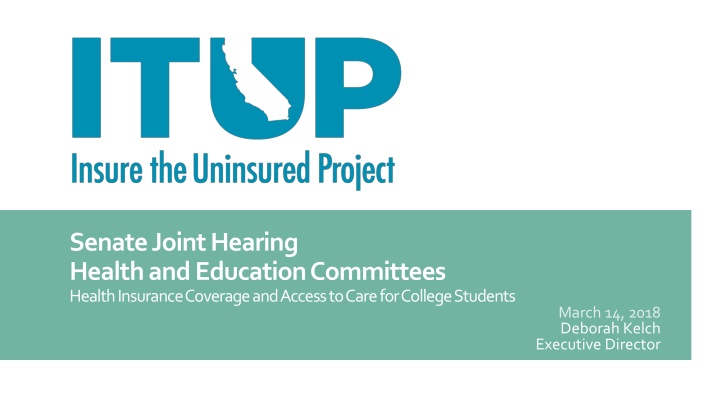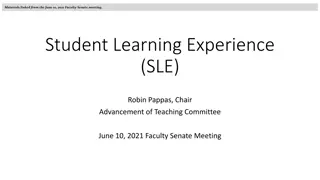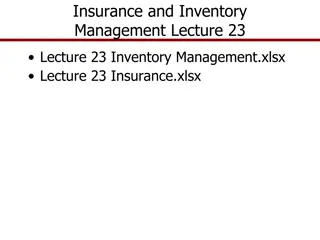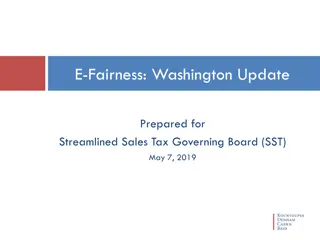
Health Insurance Coverage Options for College Students in California
Learn about the coverage and access to health care for college students in California, including key concepts like employer-sponsored insurance and dependent coverage. Explore the progress made under the Affordable Care Act and potential issues affecting young adults' access to healthcare while away from home.
Download Presentation

Please find below an Image/Link to download the presentation.
The content on the website is provided AS IS for your information and personal use only. It may not be sold, licensed, or shared on other websites without obtaining consent from the author. If you encounter any issues during the download, it is possible that the publisher has removed the file from their server.
You are allowed to download the files provided on this website for personal or commercial use, subject to the condition that they are used lawfully. All files are the property of their respective owners.
The content on the website is provided AS IS for your information and personal use only. It may not be sold, licensed, or shared on other websites without obtaining consent from the author.
E N D
Presentation Transcript
Senate Joint Hearing Health and Education Committees Health Insurance Coverage and Access to Care for College Students March 14, 2018 Deborah Kelch Executive Director
WHO WE ARE Insure the Uninsured Project (ITUP) Nonpartisan, independent 501 (c)(3) organization, founded in 1996 ITUP s mission is to promote innovative and workable policy solutions that expand health care access and improve the health of Californians ITUP implements its mission through policy-focused research and broad- based stakeholder engagement 2
ITUP Vision All Californians have the resources they need to preserve and improve health ITUP seeks a health care system that is: Universal All Californians are eligible for comprehensive health coverage and services, including primary and preventive health care services Accessible Californians have access to coverage choices and services that are available, timely and appropriate Vision/Values Affordable Coverage and care are affordable for public and private purchasers and for consumers at the point of care Effective Health care and related support services are cost-effective, coordinated, and high-quality Equitable Californians can expect fair access and treatment regardless of health status, age, income, language, race or ethnicity, gender, immigration status, geographic region, and public or private coverage 3
Provide an overview of coverage and coverage options for college-age adults in California Presentation Goals Highlight California s progress with coverage for young adults under the Affordable Care Act (ACA) Highlight potential issues affecting access to health care for college students while they are away from home 4
Overview of Coverage for College-Age Adults 5
Coverage OverviewKey Concepts Employer-Sponsored Insurance (ESI) Coverage obtained through an employer. Young adults may be covered as the employee or as a dependent (up to age 26) under a parent or guardian s employer plan. Dependent Coverage Coverage for qualified dependents of the primary subscriber or policyholder. Typically a spouse or child. Individual Mandate Legal requirement for an individual to maintain a minimum level of health coverage, as defined, for themselves and their dependents. A penalty may apply for failure to comply. 6
Dependent Coverage Coverage through parent s employer or individual family plan Coverage Options for College Students Individual Coverage Directly through Covered California (state ACA exchange) or from health plans in the non-exchange individual market Medicaid (Medi-Cal in California) For low-income legal resident students; undocumented adults have access to emergency and pregnancy Medi-Cal Student health insurance plan (SHIP) Coverage offered by the university or college the student attends 7
Sourcesof Coverage, Young Adults 19-25, 2016 3% Sources of Coverage 8% Employer sponsored Medi-Cal 13% 45% Uninsured Privately purchased Other public 31% Source: Insure the Uninsured Project; 2016 California Health Interview Survey 8
Dependent definition Health plans must offer coverage for dependents on a family plan until the age of 26 Robert Wood Johnson Foundation estimates that because of this provision the uninsured rate for young adults decreased by 4.5% nationwide in the first year of ACA implementation1 ACA Provisions Affecting Dependent Coverage Employer mandate Employers of 50+ employees must extend group health plan coverage to employees and their dependents up to age 26 or pay a tax penalty Individual mandate Individuals must maintain coverage for dependents; Federal tax penalty for failure to do so ends in 2019 1Robert Wood Johnson Foundation, Evaluating the Impact of Extending Dependent Coverage to Young Adults Under Health Reform, July 8, 2014, https://www.rwjf.org/content/dam/farm/reports/program_results_reports/2014/rwjf72286 9
Expansion of Medicaid Eligibility Enhanced federal funding to expand Medi-Cal coverage for low- income, childless adults (19-64) ACA Provisions Affecting Coverage for Low-Income Young Adults Individuals with incomes up to 138% of the federal poverty level (FPL) ($28,180 for a family of three, 2017) Premium Subsidies Individuals and their dependents with incomes below 400% FPL ($80,640 for a family of three, 2017) Individual coverage through ACA exchanges (Covered California) Eligible for tax credits that reduce the monthly premium, and cost-sharing subsidies that lower out-of-pocket costs 10
Student health insurance definition ACA Provisions Affecting Student Health Insurance Coverage offered by institutions of higher learning limited to enrolled students Accepts all students regardless of health status Meets any additional requirements in state law Student health insurance is considered individual coverage Subject to some but not all provisions of the ACA Example: Not required to offer multiple levels of coverage as in the ACA exchanges (bronze, silver, gold and platinum) but must meet minimum coverage standards 11
Sources of Coverage in California Young Adults Ages 19-25, 2009 and 2016 Coverage for young adults increased in employer- sponsored, Medi- Cal and individual coverage under ACA 39% Employer sponsored 1,411,000 45% 1,646,000 14% 508,000 Medi-Cal 31% 1,111,000 1,063,000 29% Uninsured 13% 483,000 Privately purchased 439,000 299,000 191,000 Other private 110,000 0 200,000 400,000 600,000 800,000 1,000,000 1,200,000 1,400,000 1,600,000 1,800,000 2016 2009 Source: Insure the Uninsured Project; 2009 and 2016 California Health Interview Survey 12
Uninsured Rate California Graduate and Undergraduate Students 24.6% Consequently, the uninsured rate for college students in California decreased by 16% 7.7% Pre ACA: 2010 2016 Data Source: Insure the Uninsured Project, Lookout Mountain Group, Considering Health Care Reform for the College Student Population: Update for Uninsured College Student Population, February 2018, American Community Survey Data 13
Health Coverage Models in California 14
Coverage Models: Key Concepts Health Plan Networks The list of contracted doctors, hospitals, and other health providers available to enrollees of a specific health plan. Service Areas The geographic regions, typically defined by zip code, where a health plan offers and provides coverage. Network Adequacy State and federal requirements for health plan contracted networks to ensure plan networks include a sufficient number / type of providers to offer timely, appropriate care. 15
Health Maintenance Organizations (HMOs) Offer a contracted provider network and limit coverage to services provided by the contracted network, except emergency and some urgent care Basic Types of Health Plans Often pay providers risk-based payments (monthly flat rate per enrollee) but may also pay discounted rates by service (fee-for- service) Most Californians have coverage in one of three managed care arrangements Primary care physicians coordinate services and referrals Licensed by the Department of Managed Health Care (DMHC) under the Knox-Keene Health Care Service Plan Act of 1975 (Knox-Keene) 16
Preferred Provider Organizations (PPOs) Offer a contracted preferred network but also offer cover services outside the network at a higher cost to the consumer Types of Health Plans Pay contracted providers discounted fee-for-service rates Primary care physicians do not play the same coordinating or referral management role Licensed by DMHC or California Department of Insurance (CDI) Exclusive Provider Organization (EPOs) Somewhat of a hybrid between HMOs and PPOs Coverage limited to the contracted network for non-emergency services Discounted fee-for-service provider payments Primary care physician approval generally not needed for specialty referral Licensed by DMHC or CDI 17
Medi-Cal Managed Care Models Two-Plan Model. Enrollees have a choice between two plans in the county a county-organized local initiative health plan and a commercial health plan. County Organized Health System (COHS). All Medi-Cal participants in the county enroll in the COHS. Several COHS plans serve enrollees in multiple counties. Approximately 81% of the 13.5 million Medi-Cal beneficiaries are enrolled in managed care Geographic Managed Care (GMC). In Sacramento and San Diego counties, enrollees choose from among a number of competing commercial health plans. Regional and county-specific. In the remaining 20 primarily rural counties, enrollees generally have a choice of two commercial health plans, except for San Benito county with one commercial health plan or traditional Medi-Cal fee-for-service. 18
Students, Medi-Cal and Covered California 19
Student Health Plans: Key Concepts Student Health Insurance Plans (SHIPs) Health coverage that colleges and universities make available to enrolled students. Fully Insured SHIPs A plan that a college or university purchases from a health insurance company. Self-Insured SHIPs Coverage where the college or university maintains responsibility to pay claims costs. 20
Student Health Insurance Plans (SHIPs) in California Regulated by the California Department of Insurance Fully insured SHIPs most cover essential health benefits and meet other provisions of the ACA; self-insured SHIPs do not have to meet the same minimum coverage requirements Student health insurance plans Colleges and universities often require students to pay for the SHIP, unless they opt-out, subject to proof of other coverage SHIP coverage may coordinate with student health centers on campus more easily than Medi-Cal or private health insurance; many student health centers do not accept private insurance 21
Medi-Cal Out-of-County Coverage Medi-Cal will cover eligible and enrolled students throughout California without the student having to reapply However, because most students are enrolled in managed care, students need to transfer to a health plan in the county where they are attending school to secure full coverage Medi-Cal away from home If students do not re-enroll in a local plan where they are in school, Medi-Cal coverage is limited to emergency and urgent care because they will be unable to access contracted providers 22
Employer and Individual Coverage (including Covered California) Students under age 26 can be covered under their parent s family plan or purchase coverage on their own Private coverage away from home Most employer and individual health plans have network limitations (HMOs, PPOs or EPOs) Employer coverage may not offer networks/coverage in the student s new location; the same health plan options are not available in every Covered California region Students may need to pay the costs of SHIP, and/or transfer to a health plan in the county where they are attending school, to access contracted providers and limit their out-of-pocket costs 23
College-age young adults have more coverage options than before the ACA and the number of uninsured young adults has declined steadily Student health insurance plans (SHIP) offered by colleges and universities are one of the options, but vary by type and level of coverage Students with existing coverage may lose access to non-emergency benefits if their health plan does not offer network coverage near the college location Summary Student health centers may not accept Medi-Cal or private health insurance Students (and/or parents) may end up having duplicate coverage and costs to ensure adequate access to care both at school and at home during breaks, an especially difficult challenge for students with chronic health conditions and ongoing care needs 24






















